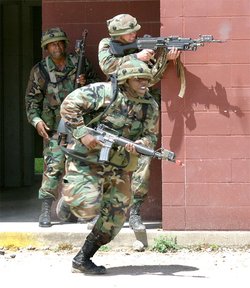Urban warfare
|
|
Urban warfare is warfare conducted in populated urban areas such as towns and cities. The U.S. military term is MOUT, or (Military Operations on Urban Terrain). The British military term is FIBUA (Fighting in Built-Up Areas).
Warfare inside a city is very different from a traditional open-field battle against a conventional army. A complicating factor of urban warfare is the presence of civilians, sometimes as combatants of various sorts, ranging from armed militias to people defending their homes against all comers, usually with many innocent non-combatants trying to stay out of the way of the battling forces. The military operations are also complicated by limited fields of view and fire because of buildings, large amounts of concealment and cover for defenders and the ease of placement of booby traps and snipers. This brought a new force into military tactics.
Traditional World War II military operations often relied on large quantities of artillery fire, which many modern armies will try to avoid as a way of reducing civilian casualties. A notable exception to this was the Russian attack on Grozny in which large amounts of artillery fire were used. The Russian army handled the issue of civilian casualities by warning that the city would be levelled and that any civilian should leave the city before the attack began.
Usually the weaker party in a war tries to enforce urban warfare on the attacking force. This is due to several reasons:
- A populated city is much harder to conquer than an open field. This is because an invading force must expend massive amounts of manpower to secure a myriad of structures without indiscriminately bombing them.
- The urbanized city is much easier to defend because it has many tall buildings, narrow alleys and sewage tunnels. The buildings can provide excellent sniping posts while the alleys are ideal for planting booby traps.
- International law prohibits the use of heavy firepower and indiscriminate bombing in civilian-populated settings. Thus, the party barricading in a city won't have to face warplanes, heavy artillery and massive tank assault if it faces an army that cares to operate in a legal manner.
- "Media War": a war on urban terrain is bound to cause some civilian casualties and extreme damage to civilian property. Photos of dead civilians and ruined streets broadcast on TV make a strong impact in favor of the party barricading in the city and undermine the morale of the attacking force. (For example, the Tet Offensive was a military victory for the American forces, but was nevertheless seen as a defeat due to post-battle news coverage.)
The limited fields of view require far larger numbers of troops than open field warfare and the operations are renowned for resulting in very high casualty rates among the attacking force's ranks. The U.S. forces during the 2003 invasion of Iraq saw remarkably low personnel casualty rates, attributable to:
- overwhelming force from a wide range of platforms
- very well armored vehicles
- new Interceptor body armor, which provided excellent protection to exposed soldiers, resulting in a major shift in the type of casualties, away from wounds to the torso area, protected by the armor, and towards wounds in the unprotected arms and legs. Also noted was an increase in the boldness of troops wearing this armor once they had seen its effectiveness
- a policy of bypassing resistance where the mission allowed it
- coordination between armored tanks and infantry
- the limited degree of organization of the defenders, in part caused by attacks on command, control and communications targets
- lack of urban warfare experience in the defending Iraqi Republican Guard.
Civilian casualty rates, however, were much higher; an AP survey of records from half of Iraq's hospitals found that at least 3,240 civilians died (? wounded) between March 20th and April 20th (31 days) during the US-led invasion. It should be noted that this number does not necessarily represent the total number of civilian lives lost as many bodies were not recovered (note also that this is civilian dead in one city during only one month).
The Israeli Defence Forces developed special tactics of MOUT, resulting in very low casualties to the occupying force (about 250 soldiers in 4 years of fighting). These tactics include:
- Non linear advance of forces, swarming the AO (area of operations) from all directions.
- Use of tanks and heavily-protected APCs to mobilize troops and protect them from enemy's fire.
- Use of armored bulldozers to:
- clear path to friendly forces: both vehicles and infantry.
- safely detonate booby traps and IEDs.
- to battle gunmen barricading in rigged buildings.
- destroy or create ground obstacles
- Use of superior CQB technologies such as advanced sights, night vision devices, body armor and advanced C4IS systems.
- Use of UAVs to provide intelligence and full battle picture.
- Use of helicopter gunships to target specific threats such as rocket launchers and RPG squads.
Famous urban battles in modern time:
- Stalingrad, USSR (1942-1943).
- Warsaw, Poland (Siege of Warsaw 1939, Warsaw Ghetto Uprising 1943, Warsaw Uprising 1944)
- Budapest, Hungary (1945) After a 14-week siege the city fell to Soviet troops. Almost 70% of Buda was destroyed.
- Berlin, Germany (1945)
- Beirut, Lebanon (1980s) see: History of Lebanon
- Beijing, China (1989)
- Panama City, Panama (1989)
- Kosovo, Yugoslavia (1994).
- Grozny, Chechnya (1996, 1999 and even today).
- Mogadishu, Somalia (1992-1993).
- Jenin, the West Bank (April 2002).
- Fallujah, Iraq, (2004).
See also:
External links:
- Urban Warfare and the lesson of Jenin (http://www.azure.org.il/15-henkin.htm)
- Handbook for Joint Urban Operations (http://www.dtic.mil/doctrine/jel/other_pubs/juoh.htm)
- Full Spectrum Warrior (Game simulating MOUT Tactics) (http://www.fullspectrumwarrior.com)
- NLF: Urban Warfare Cell (http://www.livelogcity.com/users/copkiller/923.html)he:לוחמה בשטח בנוי

